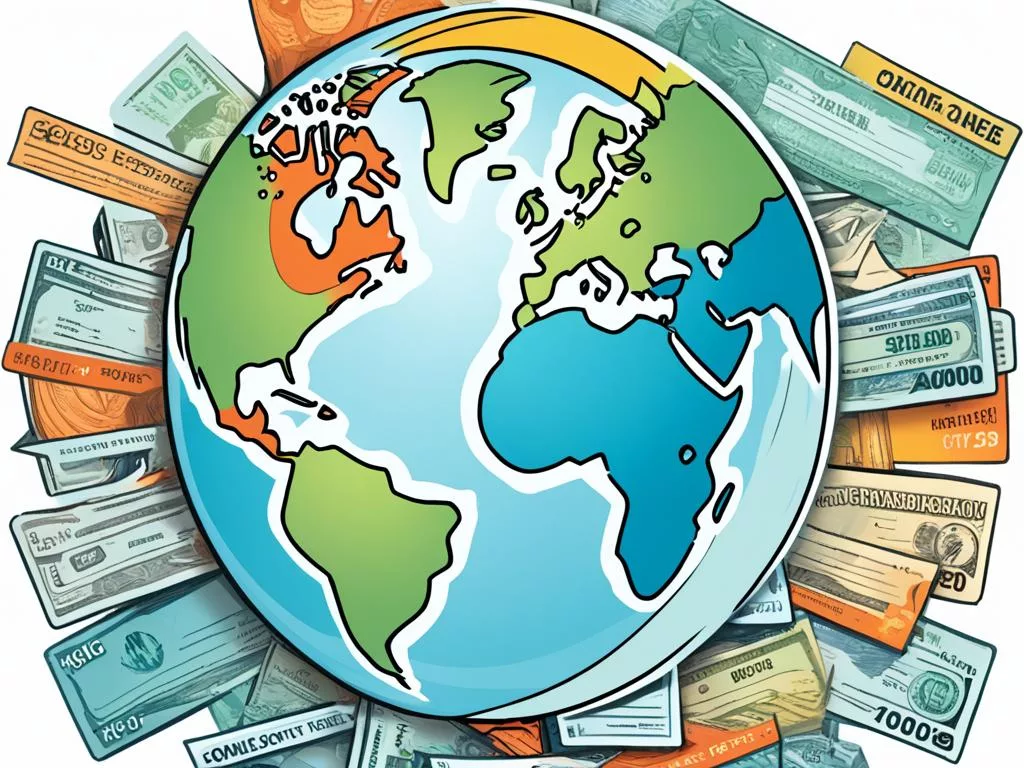Every time I initiate an international wire transfer, the anticipation pulses through my veins. It’s not just about sending money; it’s a lifeline, connecting me to family miles away or a testament to trust in an overseas business venture. The international wire transfer time is more than a duration; it’s that suspenseful wait punctuated by hope and a dash of anxiety. Whether it’s the first step in making a dream home abroad a reality or expanding entrepreneurial borders, the timeline for sending funds abroad echoes the pulse of our globalized world. Nothing quite compares to the satisfaction of wire money overseas efficiently, knowing that the fruits of your labor are traversing the globe to fulfill their intended purpose.
Meticulously managing these transactions carries an inherent sense of responsibility – each second could mean the difference between an opportunity seized or moments lost. The efficiency in which we dispatch these digital lifelines can define relationships, investments, and futures. In unraveling the timeline of wiring funds abroad, we uncover the meticulous dance between urgency and security, a balance that governs the transfer from our hands to those awaiting on distant shores.
Understanding the Basics of International Wire Transfers
When I explore the realm of sending money internationally, I’m faced with a myriad of details that shape the wire transfer duration and overall experience. International wire transfer time is a critical aspect that hinges on several factors, each playing a pivotal role in moving funds across borders efficiently. For instance, when dealing with established currencies, like US dollars and euros, the transfer process is generally swift, taking approximately one to two days. Nonetheless, when weaker currencies are involved or when multiple conversions are required, this duration can extend up to five days1. This naturally piqued my interest in the services offered by innovative fintech companies, like Inpay, which can drastically reduce international money transfer time to an average of just 30 minutes, circumventing the typical SWIFT wire fees1.
My attention is particularly drawn to the agility of Inpay’s SEPA payouts in Europe, which boast delivery times ranging from mere minutes to the same day at the latest. The combination of rapid processing times and high efficiency makes them an appealing choice for wire funds abroad1. Boasting a staggering success rate of 99.5% in over a million transactions a month, Inpay demonstrates a commitment to reliable and speedy cross-border payments1.
However, the venture of wiring funds abroad isn’t without its challenges. As I’ve learned, variances such as fraud prevention protocols, different time zones, obligatory currency conversions, and even delays introduced by bank holidays and weekends can significantly decelerate the wire transfer process1. It’s these unforeseen elements that remind me of the importance of choosing the right service for my international money transfer needs, balancing both time and cost considerations.
Imagine my surprise when I discovered the costs associated with these transfers. For an incoming domestic wire transfer, the average fee hovers around $14, with an outgoing domestic transfer bumping the fee to nearly $282. These fees escalate further in the context of international transactions, where incoming and outgoing transfers tend to carry average fees of $18 and $50, respectively2. Even well-known banks like Bank of America vary their charges for these transfers, which emphasizes the need for meticulous planning and comparison2.
Amidst this financial landscape, services like TransferWise present themselves as a cost-effective alternative. With their person-to-person transfer model, the starting fee for transferring USD is as low as $3, although this can increase to around 1% of the transaction value for larger amounts, in addition to any supplementary fees2. This makes examining different platforms an essential step in my approach to wire funds abroad efficiently.
- Quick Transfer Times with Fintech Solutions
- Affordable Fees for International Transactions
- Seamless SEPA Payouts in Europe
- Accessibility to Worldwide Currencies

In conclusion, while I contemplate the international money transfer time and the variables that affect it, the keys to a successful and swift wire transfer lie in the selection of a proficient transfer service and an in-depth understanding of the associated costs. With this knowledge, I feel equipped to navigate the intricate web of international finance with confidence.
How Long Does It Take to Wire Money Overseas?
In my professional experience, determining the payment processing time for an international wire transfer is nuanced and varies by several factors. While domestic wire transfers within the U.S. are generally completed on the same business day3, the process becomes more complex when money needs to cross borders. When clients wire money overseas efficiently, they may expect their transaction to be processed within one to five business days3, which aligns with the guidelines provided by many financial institutions.
The SWIFT network handles a significant portion of these cross-border transactions, akin to an air traffic control system for finances4. However, something as seemingly trivial as the day of the week can impact the payment processing time for international wire transfers. Transfers initiated late in the week, or right before holidays, are prone to delays, as non-business days extend the timeline3. Therefore, initiating a wire early in the workweek is preferred to avoid additional holdups.
Service providers like Western Union offer various methods for sending money overseas, including options for faster express delivery that may reduce processing times to 2-3 business days5. For financial operations conducted through the U.S. Department of State, a notable $30 processing fee is charged annually, and regular transfers are processed during business hours, with after-hour transactions carrying over to the next day5.
Given my focus on payment processing times, I’ve formed an insightful table that contrasts the time it takes to process different types of monetary transfers:
| Transfer Type | Processing Time | Fees |
|---|---|---|
| Domestic Wire Transfer | Same business day3 | $0 to $35 (on average)4 |
| International Wire Transfer | 1 to 5 business days3 | $44 (on average for outgoing)4 |
| Express Delivery (Western Union) | 2-3 business days5 | Varies by amount + $30 (U.S. Department of State fee)5 |
| U.S. Department of State Transfer | During business hours (next day if after-hours)5 | $30 processing fee5 |
Transactional fees also play a role in the wire process, with international outgoing wire fees averaging $44, while some institutions, such as State Employees’ Credit Union, offer more economical rates, charging only $25 for outgoing international transfers4. When clients are seeking to wire money overseas efficiently, I often advise them to compare the services and fees of different providers to optimize both cost and speed.
Fortunately, today there are numerous alternatives to traditional wire transfers, such as PayPal and Wise, which could offer more beneficial terms4. In the evolving landscape of digital finance, being informed about the nuances of payment processing time for international wire transfer is imperative for those looking to wire money overseas efficiently.
The Cost Implications of Wiring Funds Abroad
When it comes to understanding the real cost of wiring money overseas, the nuances go beyond just the numbers reflected on a service fee chart. I’ve discovered that the median cost of international wire transfer fees for tax payments is a variable that can influence a taxpayer’s choice of transfer method6. With this in mind, it’s troubling to note that a significant percentage of foreign banks lack the capability to manage international wire transfers, adding a layer of complexity for taxpayers who have cross-border financial obligations6.
Comparing the statistical data, I observed that fees between small local banks and large financial institutions for international wire transfers paint a compelling picture. Small local banks often have higher international wire transfer fees due to their limited operations scale, whereas large financial institutions can offer slightly more competitive rates due to their broader international foothold6. This positions major financial institutions as a potentially more affordable route for international wire transfer fees, though still costly.

In my quest to ascertain the cost of wiring money overseas, I factored in the hidden expenses charged by some wiring services. For instance, Western Union’s money transfer fee is based on the dollar amount being sent, which is in addition to the U.S. Department of State’s once-per-fiscal-year $30 processing fee for international account transfers5. Moreover, there’s quite a spectrum of delivery timescales, ranging from the 3-4 days with express courier services to the protracted 3-4 weeks via U.S. Postal Service mail—a direct result of stringent internal mail-screening security procedures5.
What’s enlightening is the growing occurrence rate of taxpayers who favor international wire transfers over credit card payments for tax liabilities. This trend could be ascribed to the transparent fee structures of wire transfers as opposed to sometimes obscured credit card charges6. Furthermore, a notable percentage of international wire transfers are initiated by U.S. taxpayers without a U.S. bank account, showcasing the global nature of today’s fiscal responsibilities and the essential need for international financial service accessibility6.
Beyond the fees, it’s wise to contemplate the influence of exchange rates, which fluctuate daily and can substantially affect the final amount received by the recipient7. This potential for significant disparities between different wiring locations underlines the importance of comparing fees and total costs before proceeding with a transfer7. And with the shadow of fraud always looming, precautions like only wiring money to known individuals and inquiring about the complete breakdown of the transfer—how much the recipient will actually get, the currency they’ll receive it in, and any deductable fees at their end—are non-negotiable steps for a secure transaction7.
| Service Provider | Fee Structure | Delivery Timeframe | Currency Exchange Practice |
|---|---|---|---|
| Small Local Banks | Higher fees due to scale | Varies | Daily exchange rate |
| Large Financial Institutions | Competitive fees | Varies | Mid-market rate markup |
| Western Union | Dollar amount based, plus fixed processing fees | 3-4 days (express) to 3-4 weeks (mail) | Daily exchange rate impact |
| U.S. Department of State | Annual $30 processing fee | Dependent on mailing method | Applicable currency exchange rate at transfer time |
At the end of my investigation into the cost of wiring money overseas, it’s evident that a thorough understanding of the fee structures, time implications, and currency exchange practices is paramount for making financially savvy decisions. Whether you’re a taxpayer settling international dues or simply looking to support family abroad, getting a grip on the international wire transfer fees landscape could lead to substantial savings and avoid the distress of unexpected costs657.
Steps to Sending International Wire Transfers
As I navigate the transfer money overseas duration, understanding each step in the international wire transfer process ensures efficiency and precision. To begin, comprehensive recipient information must be collected, which includes names, accurate banking details, and the destination country’s specific requirements such as SWIFT or BIC codes. It’s important to note that generally, international wire transfers should arrive within 1-5 business days if sent before the bank’s cut-off time8.
For example, many US banks such as Bank of America and Chase Bank have specific cut-off times of 5 PM and 4 PM EST respectively for initiating these transfers8. Time is of the essence; therefore, being aware of these windows is crucial in optimizing the sending funds abroad timeline. However, factors like bank holidays, weekends, and the choice of currency can add unexpected delays89. Consequently, it’s advisable to initiate transfers early in the day and earlier in the week to mitigate these potential delays.
Additionally, choosing an efficient service like Wise, which reports that 45% of their transfers are instantaneous, could streamline the process considerably8. However, traditional ACH transfers may take 2–3 days but are often a less expensive alternative9. It is a complex balance between speed and cost, as the average cost for sending a wire transfer hovers around $279.
Service choice could influence the timeline significantly since banks might slow down transactions to prevent fraud, with some transfers taking up to five business days or longer to be reflected in the recipient’s account8. In contrast, non-banking services like Wise often provide estimated arrival times for transfers considering various factors, offering a degree of predictability8.
When I opt for wire transfer, I’m leaning towards a method preferred for critical transactions in business, such as large purchases or international money transfers, due to their reputation for speed and security9. Nevertheless, being mindful of the irreversible nature of wire transfers and potential exposure to scams9 demands vigilance during every step. Lastly, should there be concerns about transfer completion or delays, the ability to trace the process using a unique IMAD/OMAD ID provides assurance9.

Understanding the nuances of intermediary banks is essential too. The number of intermediary or correspondent banks involved can directly impact the speed of a wire transfer8. In today’s interconnected banking system, transfers might pass through several banks before reaching their final destination, analogous to layovers in air travel. FedWire can facilitate immediate transfers between US financial institutions, while the SWIFT network takes care of secure international wire transfers, connected by the Society for Worldwide Interbank Financial Telecommunication9. Notingly, the timing of initiating the transfer, the receiving bank’s processes, and the pathway the transfer takes via intermediary banks altogether influence the completion time of a wire transfer89.
In conclusion, meticulous attention to recipient details, strategic planning around bank cut-off times, and selecting an appropriate transfer institution can markedly impact the sending funds abroad timeline and transfer money overseas duration. With an informed approach, I ensure the wire transfers I conduct are not only time-efficient but also secure and cost-effective.
Options for Selecting Exchange Rates in Wire Transfers
When I’m engaged in international money transfers, my primary focus often shifts to obtaining favorable international wire transfer exchange rate options. I’ve found that services like OFX, Wise, and others provide competitive rates with lower margins than conventional banks, which is ideal when I’m looking to optimize my exchange rate selections10. There’s a diverse range of factors influencing the rates I can access, from the volume of money I’m transferring to the specific provider I choose. What I’ve come to recognize is the importance of avoiding exchanges at locations such as airports where the convenience cost can outweigh the benefits10.
I must admit, there’s a plethora of selection when it comes to providers. OFX, WorldRemit, Wise, and similar online platforms not only extended to me rapid transaction times but also lower fees, providing a strong case for their use in international wire transfers10. Through comparison, I found that these providers can be particularly advantageous for larger transfers as they often offer stronger exchange rates in such scenarios10. As a discerning user, I’m also keen on ensuring the convenience of having the transferred funds readily available for pickup or deposit, highlighting international money transfer services as highly reliable options10.
Considering the financial implications, I’ve also taken note of the typical charges banks apply, with international wire transfer fees ranging from USD 20 to USD 5011. Banks like Bank of America and Wells Fargo sit at the higher end of this spectrum with their fees11. Nonetheless, JPMorgan Chase has an intriguing model for those like myself who prefer managing transactions digitally, offering a significantly reduced fee for self-serviced wire transfers through their app or website11.
My vigilance extends to the transfer duration as international wire transfers generally complete within 2-5 working days11. This consideration is paramount especially when I keep in mind the recipient’s country, banking holidays, and the cut-off times, which can unquestionably influence the processing time11.
I’ve developed a habit of precise currency trend monitoring, which informs me when to carry out money exchanges that can result in considerable savings, particularly for sizeable sums10. Here is how different methods affect the exchange rate options available to me:
- Immediate conversion can be favorable if I predict a decrease in the value of the currency I’m converting to.
- Using forward contracts, I can lock in today’s rates for future transfers, which works to my benefit if I anticipate a currency rate hike.
- Limit orders serve me well when I set a target rate and wait for the market to meet my expectations. This does assume that I’m not in urgent need of the transfer and can wait for the ideal rate.
With these considerations in mind, I’ve composed a comparative table highlighting the differences between key service providers regarding fees and transfer limits, which are crucial components in my decision-making process for international wire transfers.
| Service Provider | Fee Range | Sending Limits |
|---|---|---|
| OFX | Varies by transfer size | No specific limit |
| Wise | Low & transparent | Up to $1,000,000 per transfer |
| Xe | No fees for large transfers | No upper limit |
| Western Union | Varies by destination | Subject to local regulations |
| Bank of America | USD 45 | USD 5,000 per transaction |
| JPMorgan Chase | USD 5 (self-service) | USD 250,000 per day |
Conclusively, my recommendation leans towards employing a reliable international money transfer service, one which not only offers competitive exchange rates but also aligns with my transfer needs, and timing preferences. These decisions hinge on constant market observation and mindful planning, ensuring I make the most of my international wire transfer exchange rate options.

Regulatory Aspects of International Money Transfers
As someone who frequently engages in the process of wiring money overseas, I have become particularly attentive to the regulatory considerations in wiring money overseas. Compliance with regulations like the Office of Foreign Assets Control (OFAC) is critical to ensure the legitimacy of a transaction and to protect against financial crime. For example, the average outgoing international wire transfer fee is $4412, but when transferring amounts over $10,000, such transactions are reported to the IRS. This requirement is a safeguard against money laundering and ensures that large transfers are flagged for additional scrutiny.
In the realm of non-bank transfer services, companies like Wise and Xoom introduce competitive fees and rapid transfer times, which appeal to consumers looking to minimize costs and enhance efficiency. Wise, notably, offers an average fee of just $6.42 for international money transfers and, generally, completes transfers within two business days12. Meanwhile, Xoom, apart from their 5% fee plus a fixed currency fee for international transfers, grants the capability to move as much as $50,000 per day to individuals who have gone through additional verification steps12. These offerings underscore the importance of choosing a compliant provider that both meets regulatory standards and aligns with consumer needs for cost-effectiveness and speed.
Nonetheless, understanding that a remittance transfer requires the involvement of a regulated remittance transfer provider is crucial13. While preauthorized remittance transfers allow for repeated transactions without initiating a new order each month, this automation does not circumvent the rigorous identity checks and reporting requirements mandated for transfers exceeding $3,000. It’s also important to note that when using a prepaid card directly with a foreign merchant, this interaction, according to current regulations, does not constitute a remittance transfer13. Throughout every transaction, the key is to maintain transparency and keep abreast of the evolving regulatory landscape to ensure a seamless and compliant international money transfer experience.
Source Links
- https://www.inpay.com/news-and-insights/how-long-do-international-bank-transfers-take/
- https://www.brex.com/resources/wire-transfers-required-information
- https://www.experian.com/blogs/ask-experian/how-long-does-it-take-to-transfer-money-between-banks/
- https://www.bankrate.com/banking/wire-transfer-fees/
- https://www.travel.state.gov/content/travel/en/international-travel/while-abroad/sending-money-abroad.html
- https://www.irs.gov/individuals/international-taxpayers/foreign-electronic-payments
- https://www.consumer.gov/managing-your-money/sending-money-overseas
- https://wise.com/us/blog/international-wire-transfer-time
- https://www.bill.com/blog/how-long-does-a-wire-transfer-take
- https://www.finder.com/international-money-transfers/best-exchange-rate
- https://www.remitfinder.com/blog/the-ins-and-outs-of-international-wire-transfer-services
- https://www.bankrate.com/banking/international-money-transfer/
- https://www.consumerfinance.gov/rules-policy/regulations/1005/30

